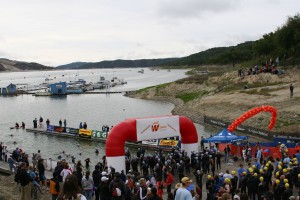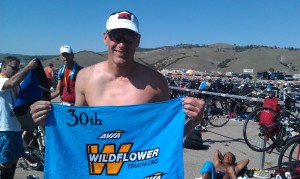 Wildflower—a world renowned triathlon classic. Here are some points on logistics and race strategy for the long course event that you might find useful.
Wildflower—a world renowned triathlon classic. Here are some points on logistics and race strategy for the long course event that you might find useful.
Arrival/camping
One of the things that makes the Wildflower experience unique is the camping. Yep, you and eight thousand of your closest triathlon friends pitch tents or park RV’s for a weekend of camping. Be sure to bring warm clothes for the evening as it can easily drop to forty degrees overnight. Bring food and plan to purchase it prior to your arrival. There is a general store located at the race site, but most campers stock up prior. Paso Robles, a town forty-five minutes from the race site, is a popular spot for last-minute purchases.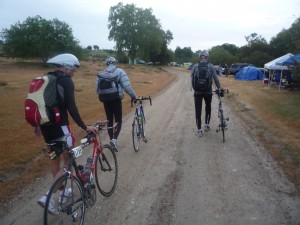
Bring water, although there is usually running water near the camps. Porta johns are numerous and are serviced regularly. Each camping area will usually have a BBQ pit and/or fire ring. Ear plugs are nice to have if you are a light sleeper as many athletes will still be arriving at the camp ground late into Friday night.
Registration opens at 12 noon. This is the best expo in the sport. Take a look around and enjoy! Again, be sure to bring warm clothing for the evenings and morning of the race. Winter hats, gloves, down jackets are not out of place here.
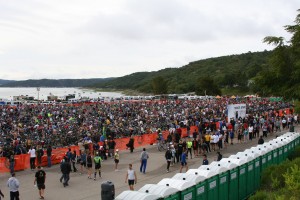 The expo area/transition area is about 1.5 miles from the camp (overflow camping, that is). Shuttles will be available, but most people just ride their bikes down to transition—down because it is all downhill to the lake. Keep this in mind because if you’ve ridden your bike down, after the race, you’ll have to haul your stuff up!. A nice backpack or transition bag is essential to carry all of your gear down to the race start in the morning.
The expo area/transition area is about 1.5 miles from the camp (overflow camping, that is). Shuttles will be available, but most people just ride their bikes down to transition—down because it is all downhill to the lake. Keep this in mind because if you’ve ridden your bike down, after the race, you’ll have to haul your stuff up!. A nice backpack or transition bag is essential to carry all of your gear down to the race start in the morning.
Swim
When you arrive at the transition area race morning, plan on having a bit of a wait for your start. Depending on your wave, it could be an hour or more. Expect 20+ waves at this race. Set up your transition area, take care of the porta john business, and then hang out and watch the early waves head out. The swim in Lake San Antonio is one of the nicer parts of the course. Expect cool water in the 60s. The course does not head into a rising sun, so sighting is pretty straightforward. 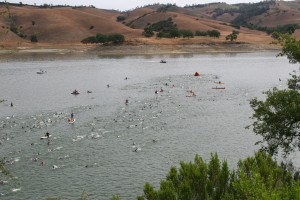 Try and swim at a steady level 2-3 pace. The effort should feel less urgent than an Olympic distance race. Nice and steady—it’s a long day. Once out of the swim, complete your transition.
Try and swim at a steady level 2-3 pace. The effort should feel less urgent than an Olympic distance race. Nice and steady—it’s a long day. Once out of the swim, complete your transition.
Bike
The first mile or so of the bike is along the lake on a rough road. If you plan on doing a flying mount and putting your shoes on underway, try and complete it sooner rather than later as the road gets rougher the further you get from transition. After about the first 1-2 miles, you turn right and head up the first climb of the day. This is called Beach Hill and is very tough. Having just exited the swim, your legs might not be quite ready for a climb yet. As soon as you hit the hill, shift into your easiest gear. A 12-27 cassette is recommend in the back and a 52/39 in the front. Also, if you have a choice of wheels, pick the lightest pair you have. Shift straight to the 27 for this climb and try and maintain your rpms as well as you can. If your rpm starts to decay below about 60, then get out of the saddle and use your body weight to get over the steepest part of the hill. This climb will feel tough, but tell yourself that it is one of the hardest climbs of the day. It gets easier from here. After cresting Beach Hill, you’ll experience about 10 miles of big rolling hills. You will hit 35+mph on the downhills, which helps you to carry some momentum into the uphills. Try not to overwork this section. Your effort for the first 15 miles should be mostly level 2. You should feel like you are out on a normal long training ride. Do not ride the first 15 miles at level 3 or harder or you will fade dramatically on Nasty Grade and the last 10 miles of the ride.
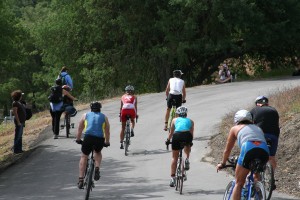 At about the 15-mile point, the course flattens considerably and becomes flat to gently rolling. If there is no wind, then this is a fast part of the course. You can now build your effort to a steady level 2-3. You should feel like you are at tempo pace or just below tempo.
At about the 15-mile point, the course flattens considerably and becomes flat to gently rolling. If there is no wind, then this is a fast part of the course. You can now build your effort to a steady level 2-3. You should feel like you are at tempo pace or just below tempo.
At mile 38 or so, you will cross a metal bridge. Many people consider this the beginning of Nasty Grade and the return to the hills. The road does not really start climbing after the bridge, but it will definitely feel like you are on a false flat. About a mile or two past the bridge, the climb starts in earnest. Soon, you will find yourself in your easiest gear again. Find a steady rhythm—something you can sustain for the next 15-20 minutes. The hill gets steeper the longer you are on it. About halfway up, you will see an aid station. If you have some fluid left in your current bottle, you might want to avoid grabbing another one here as the extra 500 grams is just dead weight for you to carry onto the steepest part of the climb. At the top of the climb, you will see many fans and what appears to be the top of the hill—do not be fooled! You will turn right at this point and continue to climb for another 5 minutes. Be mentally prepared for this and it will make that last bit of the climb easier to deal with.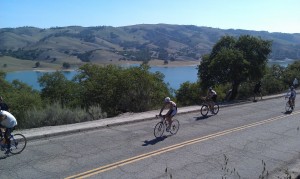
Once at the real top of the climb, you will encounter the biggest descent of the day. The road curves to the right and drops steeply before curving back to the left. It is not uncommon to hit 50mph on this descent. Use your head and only go as fast as you are comfortable. Sit upright for more aerodynamic braking and use your brakes, as necessary, to feel safe. Once off of the descent, you will be about 9 miles from the transition area. Believe it or not, this is the toughest part of the course. You have made it over the most challenging climbs and are about 46 miles into the ride. It is easy to check out mentally at this point. However, these last 9 miles are over big, rolling hills back to the park. With accumulated fatigue and the rising temperatures, these last 9 miles are hard. Be prepared for them and keep telling yourself that the race is not over after Nasty Grade.
The last mile of the ride is all downhill back to the lake and the transition area. If you paced the first 15 miles well and used your easiest gears on the climbs, then you should be ready to head out to the half marathon run in good shape.
Run
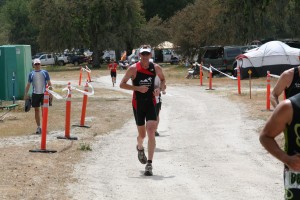 The run course starts with a 2- to 3-mile section along the lake on the same bumpy road that you rode to start the bike. There are short, steep hills along the way. Shorten your stride and keep your cadence high on these rollers. You may even consider walking the steepest pitches in order to save some energy for later in the run. Aim at running a level 1-2 or 2-3 pace depending on how you are feeling. After about 3 miles, you arrive on the trails. For the next 7 miles you will be running on fire roads and trails. It is beautiful, but it can get hot. Be sure to stay wet by dousing yourself as much as possible at aid stations. Between miles 4 and 5, you will find the steepest climb or series of climbs on the run. The trail turns steeply up for about a mile. Many people choose to power walk this section. More power to you if you can run it! The top of the steepest pitch has typically been the location of the infamous “naked aid station.” The organizers have tried to stamp that out, but don’t be surprised to find naked co-eds handing you a drink!
The run course starts with a 2- to 3-mile section along the lake on the same bumpy road that you rode to start the bike. There are short, steep hills along the way. Shorten your stride and keep your cadence high on these rollers. You may even consider walking the steepest pitches in order to save some energy for later in the run. Aim at running a level 1-2 or 2-3 pace depending on how you are feeling. After about 3 miles, you arrive on the trails. For the next 7 miles you will be running on fire roads and trails. It is beautiful, but it can get hot. Be sure to stay wet by dousing yourself as much as possible at aid stations. Between miles 4 and 5, you will find the steepest climb or series of climbs on the run. The trail turns steeply up for about a mile. Many people choose to power walk this section. More power to you if you can run it! The top of the steepest pitch has typically been the location of the infamous “naked aid station.” The organizers have tried to stamp that out, but don’t be surprised to find naked co-eds handing you a drink!
Once at the top of the hill you run steeply down for about 400 yards before the trail flattens in a meadow. You will soon pass the mile 6 aid station and head into the camp grounds. At about mile 6.5, you run right through the campgrounds where 8,000 fellow triathletes and their friends/family have been camping. This is as close to the Tour de France as many of us will get. The crowds line the road and cheer like crazy. It is an absolute rush. Be sure to control your energy as it is easy to find yourself running at level 4 before you realize it.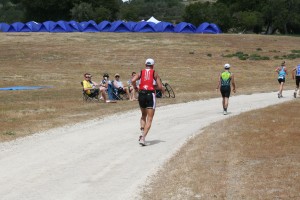
At mile 8 you leave the campground and your energy leaves too! Be prepared for this. Once you leave the campground, stay focused and make mile 10 your next goal. At mile 9, you leave the trail and get back on the road and climb a short hill. You run down this hill for 1 mile—which is nice—until you realize that you have to run back up this hill. Mile 10 comes at the turnaround at the bottom of the hill. If you are doing well, you should try and run up the hill steadily. If you are struggling, then consider walking for 1 minute and running for 2 minutes to get up the hill.
From the top of the hill, you have about 2 miles to go! After cresting the last hill of the day, you run downhill for a mile. Stay under control and keep your cadence high. This can be a painful run as your quads are about done. At the bottom of the hill, you will hear the announcers’ voices and the music. You have 400 yards to the line – kick it in and finish with a smile!
Post-race
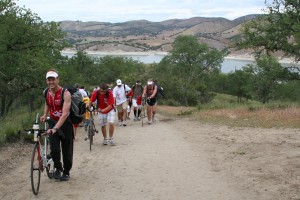 Take your time to fully recover in the post-race area and let your body cool. Once you feel ready, you can tackle the last leg of the race—the hike back to the campground. It is a 1.5 mile hike on steep trails to get back (if going to overflow camping). This is where your backpack really comes in handy. Once back at the campground, kick back and enjoy having finished one of the greatest long course events in the world!
Take your time to fully recover in the post-race area and let your body cool. Once you feel ready, you can tackle the last leg of the race—the hike back to the campground. It is a 1.5 mile hike on steep trails to get back (if going to overflow camping). This is where your backpack really comes in handy. Once back at the campground, kick back and enjoy having finished one of the greatest long course events in the world!
Nutrition Info
As for any long course race bike leg, aim at drinking 20oz of fluid per hour, eating 100-300 calories per hour, and ingesting at least 400mg of sodium per hour. Once on the run, drink a mouthful of fluid at each aid station, eat a gel every 45-60 min and be sure to get at least 400mg of sodium down. Products on the course normally include Gatorade Endurance Formula and Power bars and gels.
Good luck!


